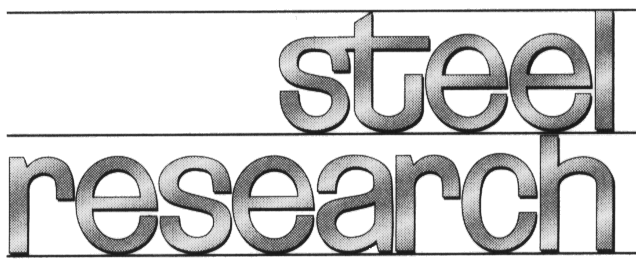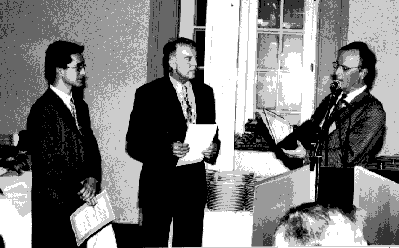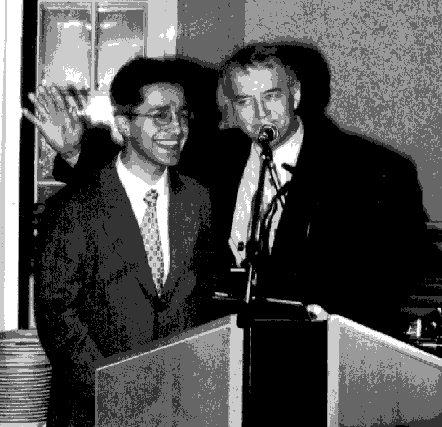

Best Paper Award
Research results are commonly circulated on the occasion of congresses or by publication in technical journals.
steel research, the scientific journal edited by the Verein Deutscher Eisenhüttenleute, VDEh (the German Iron and Steel Institute), and the Max-Planck-Institut für Eisenforschung, MPI, presents the latest results of fundamental research in the fields of metallurgy, metal working and materials science as far as the material steel is concerned. Formerly well-known as "Archiv für das Eisenhüttenwesen", steel research looks back on 67 years of experience in worldwide exchange of technological basics.
In 1994, the editors decided to offer a Best Paper Award with a thousand
US-$ purse and a pretty diploma.
![]()
This year, the 3rd Best Paper Award was presented on the occasion of the 13. ASK Aachener Stahlkolloquium featuring Metal Working in Aix-la-Chapelle on March 26th, 1998.
In their annual meeting the steel research Editorial Board decided
to present
Ignacio González-Baquet, Radko Kaspar,
Johannes Richter, Georg Nußbaum
and Alfred Köthe
Dr.-Ing. Ignacio González-Baquet, (now with Aceralia, Asturias, Spain); Dr.-Ing. Radko Kaspar, Max-Planck-Institut für Eisenforschung, Düsseldorf; Dr.rer.nat. Johannes Richter; Dipl.-Ing. Georg Nußbaum; Professor Dr. sc. nat. Alfred Köthe, Institut für Festkörper- und Werkstofforschung, Dresden.
with the
Best Paper Award 1997
for the paper:
Influence of microalloying on the mechanical properties of medium carbon forging steels after a newly designed post forging treatment
in "steel research" 68 (1997) No. 12, p. 534/540
For more than twenty years the classical quench and tempering of medium carbon Cr-alloyed steels has been substituted in the production of drop-forged parts for the automotive industry by a direct continuous cooling of less expensive V-microalloyed steels with lower carbon content. However, this simplified treatment has serious limitations concerning the yield strength and ductility if compared with the properties after quench and tempering. On a group of such V-bearing steels additionally microalloyed with Ti and Nb and with different N contents, an alternative two-step-cooling (TSC) strategy after forging, combined with an additional annealing (AN), has been applied. This new post forging treatment results in a significant improvement of the final mechanical properties. The paper is focused on the particular contributions of a different microalloying in the optimized deformation schedules to improve mechanical properties after TSC + AN. The aim of this additional microalloying is to achieve a more homogeneous distribution of ferrite in the final multi-phase microstructure due to a proper austenite conditioning as well as to make a full use of the strengthening potential of vanadium in these forging steel grades.
Einfluß der Mikrolegierung auf die mechanischen
Eigenschaften von Schmiedestählen mit mittleren Kohlenstoffgehalten
nach einer neuartigen Schmiedenachbehandlung.
Seit mehr als 20 Jahren
wird bei der Herstellung von gesenkgeschmiedeten Teilen für die Autoindustrie
das klassische Vergüten von Cr-legierten Stählen mit mittlerem
Kohlenstoffgehalt zunehmend ersetzt durch die kontinuierlich gesteuerte
Abkühlung von Schmiedestücken aus kostengünstigeren, V-mikrolegierten
Stählen mit niedrigerem Kohlenstoffgehalt. Jedoch bringt diese wesentlich
einfachere Technologie Einschränkungen bezüglich der erreichbaren
Werte von Streckgrenze und Duktilität mit sich, verglichen mit den
Eigenschaften nach Vergütung. Daher wurde für eine Gruppe von
V-Stählen, bei denen zusätzliche Mikrolegierungen mit Ti, Nb
und unterschiedlichen Stickstoffgehalten erprobt wurden, alternativ eine
zweistufige Abkühlung (TSC) von Schmiedetemperatur mit nachfolgendem
Anlassen (AN) bei relativ niedrigen Temperaturen entwickelt. Diese neue
Schmiedenachbehandlung ermöglicht eine signifikante Verbesserung der
mechanischen Eigenschaften. Der Beitrag befaßt sich speziell mit
der Wirkung unterschiedlicher Mikrolegierungen bei optimal gestalteten
Stichplänen im Hinblick auf die Verbesserung der mechanischen Eigenschaften
nach TSC und AN. Das Ziel der zusätzlichen Mikrolegierung besteht
darin, eine homogenere Verteilung des Ferrits im Endgefüge durch günstige
Konditionierung des Austenits zu erreichen und das Ausscheidungspotential
des Vanadins in diesen Stählen möglichst vollständig auszunutzen.

Dr.-Ing. Radko Kaspar, centre, and Dr.-Ing. Ignacio González-Baquet, left, acting as representatives of the other authors, listen to the laudation held by Professor Dr. rer. nat. Peter Neumann, right, director of the Max-Planck-Institut für Eisenforschung GmbH and thus co-editor of steel research.
All over the world great effort is being made in research
and development to lower the weight of automobile parts. One possibility
is the increase of strength so that bearing cross-sections can be reduced.
Drop-forged parts of Cr-alloyed steels with medium carbon content are used
in many cases. It has been attempted to save on expensive alloying elements
for a long time now and to replace the time-consuming classical hardening
and tempering after forging by controlled cooling immediately from the
forging temperature. But up to now losses in strength and ductility have
had to be taken into account.

Dr.-Ing. Radko Kaspar and Dr.-Ing. Ignacio González-Baquet, who is now with Aceralia, Asturias, Spain, expressed their gratitude to the steel research Editorial Board.
This prize-winning paper now shows an innovative way to how a spectrum of mechanical properties, comparable to those after the classical heat treatment, can be reached by micro-alloying and a novel post forging treatment. For a group of V-steels, micro-alloyed with Ti and Nb, a two-step cooling with air and water, followed by tempering at rather low temperatures, was developed and tested on the hot forming simulator of the Max-Planck-Institut für Eisenforschung. The additional micro-alloying effects a favourable conditioning of the deformed austenite and with that a more homogeneous distribution of the ferrite in the final micro-structure, improving the mechanical properties.
This paper excellently demonstrates how steel products
can be further improved and produced more cost-effectively by interdisciplinary
application of the fundamentals of metal forming, materials science and
metallurgy, supported by the well-experienced method of laboratory simulation.
![]()
In their annual meeting the steel research Editorial Board decided
to present
Professor Dr.-Ing. Dr.-Ing. E.h. Dr. Sc.h.c.
Karl Heinz Kloos,
Dr.-Ing. Joachim Granacher
and Dipl.-Ing. Andreas Pfenning
Institut für Werkstoffkunde, Technische Hochschule Darmstadt
with the
Best Paper Award 1996
for the paper:
Creep equations for high temperature alloys on the basis of a parametric assessment of multi-heat data
in "steel research" 67 (1996) No. 3, p. 106/110
Creep equations describe the deformation behaviour of components as a function of load, temperature and time. With their investigation, the authors present a method to evaluate these equations. Thus, fundamental materials technology leads to a creep equation well fitted for finite element calculation of high-temperature components. The results of this investigation represent a valuable contribution to the design of high-temperature components requiring materials of complicated long-term behaviour.
The paper forms part of A. Pfennig´s doctoral thesis also presented
on the 17th lecture of Arbeitsgemeinschaft Warmfeste Stähle und Hochtemperaturwerkstoffe
in Düsseldorf.
![]()
Dr.-Ing. Dierk Raabe
Institut für Metallkunde und Metallphysik, RWTH Aachen
with the very first
Best Paper Award 1995
for his paper:
Investigation of the orientation dependence of recovery in low-carbon steel by use of single orientation determination
in "steel research" 66 (1995) No. 5, p. 222/29
The understanding of fundamental relationships and connections is indispensible
for controlled handling of steel. With this systematical investigation,
Dierk Raabe documents the course of recrystallisation and recovery in relation
to crystal orientation. Profound knowledge of textures and their effects
vastly supports all efforts aiming at an improvement of deep drawability.
The results achieved thus represent a valuable contribution to the production
of automotive sheets.
![]()